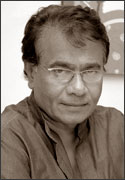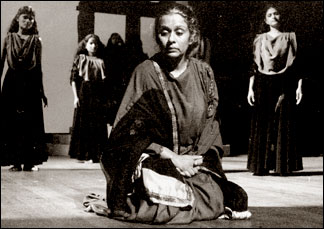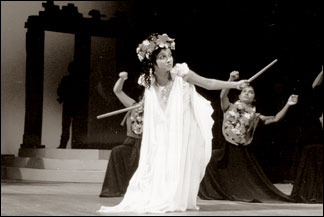Breathing life to myths
Dharmasiri Bandaranayake:
By Ranga Chandrarathne
[email protected]
|

Creator ahead of his time
|
Veteran dramatist and film maker Dharmasiri Bandaranayake analyses
the present crisis in arts and culture in Sri Lanka as a failure of the
attempts made up of intellectuals and artists to salvage Sri Lanka from
the present predicament since first decade of the 21st century.
Commenting on the theatre in Sri Lanka, Dharmasiri Bandaranayake is
of the view that the latest trend in theatre is that theatre, cinema can
be used for the purpose of spreading the message of peace since the
peace process commenced in 2005.
However, the artists who engaged in this new approach should humbly
examine whether this attempt was fruitful.
He states that the conflict in Sri Lanka is homespun and commenced
with the aim of winning the rights of a certain segment of population
who believed that they have to speak in a comprehensible language.
|

Highly impressive Trojan Women: Agony of our generation and
generations to come |
The parties to the conflict were born out of a huge political crisis
in the province in which the slogan that ‘we can only win our rights if
we speak in a comprehensible language’ came into being.
The ‘comprehensible language ‘become arms and since certain segment
of population took arms, the conflict has been dragging on for thirty
years.
Dharmasiri Bandaranayake believes that the prime motive of the Sri
Lankan artists, film makers and dramatist is to express their heart out
(certain pain in the inner soul) in their chosen media and serve
generations to come.
However, when the artists began to work within programmes associated
with the conflict which were introduced to Sri Lanka by developed
nations, the motives of arts has been drifting away from the hearts and
minds of the artists as well as of the people. This has to be examined.
Withering away of the painful approach to arts (expression of heart)
has converted the human voice into a mechanical voice similar to that of
a robot. From the last five years, it is this distorted human voice
which has come to the fore in diverse forms and throwing out different
logics and challenges.
Bandaranayake pointed out that in the 1950’s the purpose of the
artist like Prof. Ediriweera Saratchandra and the other dramatist of the
era (Henry Jayasena, Sugathapala de Silva) was to produce a higher
quality work of art and lift public taste to a higher plain.
This is characteristic of the Tamil artists. Within the ten years,
the purpose of the art has been transformed. Some artist mentioned in
interviews to the media that there were international artists.
|

Cassandra; an eternal character throughout the ages |
However, those artists in 1950s were also international artists. They
are also monumental figures in the arena of national arts. He is of the
view that the following generation who were inspired by the previous
generation have become artists. However, this aspect has been dropping
out from the scene.
He states that purpose of making a film is not for the audience but
for international consumption. For instance, Tchaikovsky, who had to
flee from Russia to escape persecution and built up a utopia and some,
could not understand him because they could not understand his mental
state. No one could bring him out of that utopia untill his death.
However he lived in his utopia as a great film maker, the fact which
is manifested in his creations. He fled the country as Russian
bureaucracy harassed him and he became an international figure.
The purpose of the film makers has become a distortion. Though the
international organisations invest money in producing higher quality
films in Sri Lanka, the purpose of the local film makers seems to be
neither of the investors’ nor of the people’s.
As the profit is earned at the initial stage of investment, these
film makers are not worried of whether the audience likes it or not. In
the cinema, this has led to a crisis. These film makers state that they
produce the films they wanted and audience could not understand their
works.
Dharmasiri Bandaranayake affirms that these film makers change their
stance at a drop of a hat as they received the profit prior to the
production of the film. There are shrewd film makers emerged from youth
whose prime motive is profit. In this case, the film maker gets the
profit beforehand the production of the film.
So they do not bother about the audience. If some one produces a film
spending Rs. 10,000,00 on it, it is not considered as a film and if
someone produces a film spending Rs 500, 000, 00 then it becomes a film.
If the foreign investor would not help, this mentality would not last
long. This has adversely affected the film makers of the same generation
who could not negotiate such deals with foreign investors.
Creator’s purpose being secondary has become an issue in cinema which
has trickled down to other media.
For instance, if a novelist’s purpose is to sell it for a tele-drama
or a film, then the motive is profit. For instance a young film maker
has used the cost of production as a weapon in the publicity campaign
for the film and that the audience should watch it because a large sum
of money has been spent on the film.
Dharmasiri stressed that this is the biggest disease that the
contemporary Sri Lankan cinema is suffering from. This attitude will
dissuade young talented youth from entering the cinema. The creativity
is something which can not be enhanced either by making the creator
afraid of or spending a huge sum on films.
Media is prepared to boost up this attitude. Speaking of the
contemporary trends in cinema, Dharmasiri recognises the new approach to
cinema whereby history is glorified against the reality. He questions
whether Sri Lanka has such a history to be glorified.
For instance, the locations such as palaces used for the production
of the film ‘Akbar’ is still available in India in its original form;
the house where Gandhi was imprisoned in Pune is still there.
History re-enforces when it is not built on myths and the fictional
history will always wither away through films, novels with
swordsmanship.
The only statement that a historic figure uttered which is in Sri
Lankan literature is the famous statement made by king Dutugamunu that
his attempts were not for kingship but for the wellbeing of the Buddhist
order. Will this render a person a heroic quality?
For instance, Indian epics such as Maha Bharata and Ramayanaya still
influence Indian arts and cinema though they are fictions born out of
history. Dharmasiri believes that history can not be artificially
resurrected.
The palaces made up of gunny bags and iron bars which were used for
shooting, would ultimately end up in used iron collectors’’ hops in
Punchikawatte. However in India , film makers would not make cardboard
palaces to be disposed after the production.
Though it is a hilarious fact, no one would find fault with the
employment of modern state-of-art technology in production. However, the
dangerous aspect of it is the shrewd management behind this process
which is yet another trick of the dangerous stage in cinema.
This trend is also manifested in television; Mahatala Hatana, Puran
Appu and Saradiel. Commenting on the entry of foreign sponsors into Sri
Lankan cinema with gradual collapse of the national film corporation,
Dharmasiri Bandaranayake pointed out that in foreign -aided cinema
profit is inbuilt in the budget and because of this, some film makers
maintain double standards; they make films about war and for war.
In this process, the creator is killed and instead there is a money
motivated businessman functioning in the guise of a director of film.
Dharmasiri questions why a campaign was not launched like the poster
campaign against not releasing negatives of the film “Prabhakaran”, for
the release of the film ‘Aksharaya ‘(Letters of Fire “in Sri Lanka if
the motive of the campaign was to further artistic freedom.
He expresses that if he happen to make a film, he would not spend
more than Rs 50, 000, 00 for it because he wants audience to watch it.
If this trend will continue, this would reduce Sri Lankan film makers
to three or four.
If some creator says that he does not bother about the audience, it
should be questioned.
He believes that present conditions ripe for the birth of a Berthold
Brecht and an audience which could appreciate such works. |
